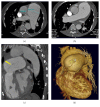Pulmonary Artery Dissection: A Fatal Complication of Pulmonary Hypertension
- PMID: 27974894
- PMCID: PMC5126397
- DOI: 10.1155/2016/4739803
Pulmonary Artery Dissection: A Fatal Complication of Pulmonary Hypertension
Abstract
Pulmonary artery dissection is extremely rare but it is a really life-threatening condition when it happens. Most patients die suddenly from major bleeding or tamponade caused by direct rupture into mediastinum or retrograde into the pericardial sac. What we are reporting is a rare case of a 46-year-old female patient whose pulmonary artery dissection involves both the pulmonary valve and right pulmonary artery. The patient had acute chest pain and severe dyspnea, and the diagnosis of pulmonary artery dissection was confirmed by ultrasonography and CT angiography. Moreover, its etiology, clinical manifestations, and management are also discussed in this article.
Conflict of interest statement
The authors declare that they have no conflict of interests.
Figures



References
LinkOut - more resources
Full Text Sources
Other Literature Sources

